The European Eel, Anguilla anguilla, is currently the subject of a conservation project being run by the Zoological Society of London (ZSL). The species has been on the International Union for Conservation of Nature (IUCN) red list of critically endangered species since 2008, although ZSL has been monitoring eel populations in the Thames catchment since 2005. The eel is also protected by the Convention on International Trade in Endangered Species (CITES).
The project is focused on monitoring the ‘recruitment’ levels of the species. Recruitment refers to the species returning from breeding grounds to live in the freshwater rivers that are their home for the majority of their lives.
In the 1950s the Thames was in such poor condition and suffering such significant levels of man-made abuse that it was declared biologically dead. This meant that the environment had become so damaged and polluted that the river was incapable of supporting any aquatic life. Thanks to efforts on the part of the Environment Agency, and other interest groups, the Thames is now back on its feet and in 2010 was awarded the International Theiss River Prize by the International River Symposium, a prestigious prize.
As conditions began to improve, eels were one of the first species to return to the river. Yet recruitment levels of European eels in the Thames had dropped by 98% from the 1980s – 2010 and it’s important that we try to understand why this massive decline in recruitment is taking place. The decline in population that’s currently being witnessed is all the more concerning in the light of the fact that the eels were keen to re-establish their populations when conditions permitted.
European eels play a key role in the ‘bigger picture’ of the river and surrounding environment and ecosystems. The eels are an important food source for many birds, fish and mammals. They are an important part of the Thames’ ecology and food chain and without them it is feared that populations of other species will suffer their own declines.
All about Eels
The European eel is a catadromous species which means it lives in freshwater for the majority of its life but migrates to saltwater in order to spawn. Their freshwater home is primarily European rivers which flow out into the Mediterranean, the North Sea and the Baltic Sea. The eels have quite a complex life cycle, and they certainly haven’t chosen the easy option when it comes to spawning. The eel spends up to twenty years living in freshwater and is thought to only spawn once as evidence suggests that they die afterwards.
The IUCN red list states that there is no concrete data about specific spawning sites but that the general site is known to be a zone of about 2000km wide in the Sargasso Sea. The Sargasso Sea is several thousand miles away from the eels’ European freshwater home and is located on the west side of the Atlantic Ocean towards the Florida coastline. Once the adults have spawned, the babies, known as eel larvae (leptocephali), make their way back to the European rivers that will be their home until they too return to their spawning grounds. It’s not fully understood how the babies make their return journey but it’s thought that they are carried by oceanic currents, at least in part. By the time they return to Europe they are no longer in larval form but have developed into tiny transparent ‘mini eels’ known as glass eels. Once they develop pigment they are known as elvers.
CEFAS has a handy diagram of the eel lifecycle. The eels go through several transformations during their lives. They start out as eggs, laid and fertilized in the Sargasso Sea. From egg to 5mm long they are known as ‘pre-leptocephalus’ before becoming ‘leptocephalus’ as they get a little bigger. Between 6-7cm they are known as ‘glass eels’ due to their lack of pigment, then as they develop pigment they are known as ‘elvers’. When they get bigger than about 7cm they are known as ‘yellow eels’ despite the fact that they are more subtle brown than bright yellow. This is the form they take for most of their lives before they become ‘silver eels’ and migrate back to their spawning grounds. The eels also undergo interesting physical changes as they become silver eels. Their eyes enlarge, and the pigments alter to allow the eel to see better in the ocean light. Their bodies become a silvery colour in order to help them blend in with the ocean and the light and thus avoid the attentions of predators.
Update March 2014: some excellent news about conservation in the Sargasso Sea has recently been published by the IUCN – Governments unite to conserve iconic Sargasso Sea:
“Governments of Bermuda, the Azores, Monaco, United Kingdom and the United States have signed a declaration committing to the conservation of the Sargasso Sea – a vast patch of mid-Atlantic Ocean known for its unique floating seaweeds that harbour rich biodiversity. This is the first time an international alliance has been formed to protect this unique haven of marine life.”
The Convention on Migratory Species has also covered this announcement: CMS Participates in Bermuda Meeting for the Signing of the Sargasso Sea Conservation Declaration.
Now that the eels’ spawning ground has been afforded this level of protection there is reassurance that if they make it to the Sargasso Sea they will find their spawning grounds intact and ready for them.
The ZSL eel monitoring in the Thames
Eels, in one form or another, are an iconic part of London culture and their decline in an area synonymous with them highlights the extremely fragile nature of their existence. But why are they declining at the moment? This is what’s not completely clear. The ZSL project is hoping that by identifying areas with low recruitment it will be possible to find patterns of behaviour and causes for the decline. Once the causes have been identified it will be important to consider them in light of the ‘bigger picture’ and so develop a sustainable plan for addressing and improving the situation.
ZSL is making good use of ‘citizen science’, using trained volunteers to help gather data about various projects. The eel monitoring is one of these ‘citizen science’ projects with many volunteers getting first hand experience of conservation activities as well as helping an important project in a very real way.
I first found out about the project through the Kingston University Biodiversity newsletter. Kingston University is located close to the river Thames, and the Hogsmill river runs through the Knights Park campus and on into the Thames. The Hogsmill is part of of the eels’ habitat and volunteers from the university biodiversity group are helping the ZSL project with monitoring eel traps at Middle Mill, a weir on the Hogsmill. This was something I had to experience for myself, a conservation project on my own doorstep involving one of London’s most iconic creatures and habitats, and run by one of the most respected organisations in the world? Sign me up! The only minor problem is that I have a very slight phobia when it comes to any fish that isn’t a goldfish. But in the name of conservation this would be overcome, the eels are rather more important than me getting a minor attack of the heeby jeebies.
Having signed up for a training session I duly made my way to the Knights Park campus at the appointed hour. The training sessions were run by Joe Pecorelli of ZSL; an engaging and enthusiastic character who could probably enthuse his students on the subject of watching paint dry, let alone eel monitoring! We were told all about the eels’ lifecycle and habits and Joe explained the drive behind the current project. Middle Mill is just one of the sites being studied in the Thames catchment area and Joe was pleased to report that eels had already been trapped at other areas, although at the time of the training session Middle Mill was sadly devoid of any.
Joe then moved on to Health and Safety. While there is often much derision directed at H&S the perils of getting into a river are not to be underestimated, even if the river looks quite small and innocent as is the case with the Hogsmill. Joe warned us of the potential for remarkably fast currents despite the relatively shallow water around the trap. A swift current combined with slippery algae covered stones on the river bed is quite capable of sending you for a very uncomfortable swim so we paid close attention! We were also warned about Weils disease, carried by rat urine in the water. Undeterred by the prospect of falling headlong into ratty waters we next headed out to the ‘tool box’. This locked box contains all the equipment we’d need for our monitoring including waders, buckets, nets, rulers etc. Armed with our kit we made our way to Middle Mill where Joe demonstrated the art of getting in and out of the river without mishap.
The eel trap at Middle Mill works by appealing to the eels’ fondness for dark places to swim through and hide out in. The eels can’t swim up the weir as the current going against them is too strong, so they look for alternatives, see the end of the trap under the water and pop in to investigate. Once in the trap, they don’t understand how to get out again so they stay inside. The traps are checked twice weekly and the design means the eels are safe from predators while having a constant flow of fresh water coming through the trap bringing food in the form of river shrimp etc. Joe told us that once one eel had been into the trap, other eels following in its fin-steps would somehow know that an eel had passed by this way already and would be more comfortable about heading into the trap. He then went on to demonstrate the trap, sadly there were no eels inside but we were all hoping that our check duties would be, well, more eely!
Joe Pecorelli of ZSL talks about the eel monitoring in the Thames
Eel trap checking
Monday 8th July 2013 was the day of my first check. It was a beautiful sunny day, Andy Murray had won Wimbledon the day before and Chris Froome had taken the maillot jaune in the Tour de France so I was hopeful that the eels would make up a hat-trick for me! The traps are always checked by at least two people and I met up with my fellow trap checker after work. Gary is a second year student whose degree is nothing to do with eels or their like; like me he was just keen to get involved and do some hands on conservation work however minor our efforts appeared.
Gary generously offered me the first go in the river while he stayed on the bank in case of disaster. If we struck gold I’d return for the bucket and then bring them back to the bank. The water was only about a foot deep, if that, but it was coming over the weir at quite a pace. The trap is a large metal box with covered ‘run up’ into it. The ‘run up’ has brushes in it which help the eels wiggle up the slope and into the trap. The entrance to the trap is a funnel with the wide end being the bit the eels see first. Once they’ve gone through, they can’t figure out how to get back out through the narrow side. The box section has a second ‘run up’ which brings fresh water and bugs into the box from the top of the weir. The eels can’t get out through this second ‘run up’ so they sit and await rescue.


Sadly the eels had not entered into the spirit of the weekend’s sporting triumphs and were nowhere to be seen. A good rummage and swish about of the trap cage revealed lots of river shrimp and a variety of bugs and mini-beasts. For about a nano-second I almost convinced myself that a freshwater leech/flatworm was a previously undiscovered species of pygmy eel but even I had to admit it wasn’t!
Thursday 11th July once again found me heading to Middle Mill, this time with Helen, a local resident and one time student at the university. Helen had found out about the project through previous involvement with the university and commented that it was great that the uni was able to get involved with the local community. Seeing as I’d been in the river before, and Helen had offered her student partner first go on her previous check (a marine biologist, she felt it was important that the student got a go!) we decided Helen should go first this time. Sadly, once again, the trap was devoid of eels. Still, we knew that a zero count told a story in itself and zero counts are submitted to the ZSL data website as well as finds so we felt we’d at least achieved something.
Last year the entire season’s trap checks found just one eel in the Middle Mill trap. We knew this so we weren’t completely surprised at our lack of eels.
However, in true Blue Peter style, here’s some eels we prepared earlier! Huge excitement surrounded the discovery of not one but three yellow eels in the Middle Mill trap during a check on 13th June 2013. The three amigos were quite a decent size, definitely yellow eel stage, so this is encouraging.
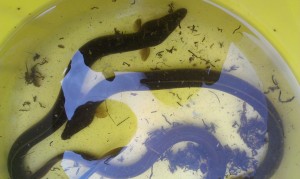

I have one more check on my rota for next week so am still hoping for a find. The checks carry on into September though so there’s still time for more eels to get themselves involved!
Eels have been found on other locations that the project is checking, so the story isn’t without hope. Joe also tells me that ‘eel tiles’ are being installed in the Hogsmill near where it flows into the Thames. These will hopefully ease the eels’ journey through certain sections of the Hogsmill and thus increase the numbers making their way upstream.
As the data builds up from the Hogsmill and other rivers it will start to show a picture of what the eels are up to. This will help ZSL identify barriers to the eels’ migration and work with various parties to alleviate those barriers. This is a classic case of ‘it’s not just a fish’ – this is a species in decline whose decline also threatens the survival of other species. It’s all part of the ‘bigger picture’ and one we very much need to understand if we are to prevent further declines of this and other species, and to maintain the rivers in as healthy and viable a way as possible.
Update 20th July 2013
On Thursday I met up with Peter, an estates project manager, for my final check duty. Peter had decided to get involved as part of his remit covers the section of the Hogsmill where the trap is located. The weather has been really hot and the Hogsmill is quite low at the moment so we were dubious of our chances of finding any eels. We’d had a brief discussion about the possible merits of a rain dance but meteorology was determined not to oblige and the sun shone regardless! Likewise the eels were not obliging either and once again the trap was empty, bar the now familiar collection of surprised shrimps and bugs.
Update August 2013
It seems the interest in eels is spreading as I’ve had a few (non-fishy!) people alert me to various eel stories in the news recently.
River’s eel population soars 130 fold in a year (River Great Ouse 31st July 2013)
South Yorkshire schoolchildren reintroduce eels to rivers (8th July 2013)
Eels to be helped back into Lake Windermere (11th August 2013)
West Cumbria Rivers Trust: Fish Easement and Eel Passage
Update 20th August 2013
Hot off the Hogsmill press! Yesterday there was much excitement at Middle Mill when the trap check revealed two more eels! The Middle Mill Two are smaller than the Three Amigos; elvers rather than yellow eels. The eel tiles mentioned earlier are now installed downstream towards the Thames end of the Hogsmill, so it’s possible that they are already giving the eels a helping hand and enabling them to get up the river and into Middle Mill. This article from the Thames Anglers Conservancy explains more about the eel tiles and how they work.
Sometimes it just takes a few very simple measures to counter the effects of man’s environmental alterations. ZSL’s use of the eel tiles shows how studying the eels has helped them identify where some of the barriers to their migration routes are. Understanding the eels’ behaviour has enabled ZSL to find a solution to at least one of these barriers. With more information being gathered the project has a good chance of being able to overcome further barriers and help the eels get back to the environments they want to inhabit.
The photos below show the eels being measured. The measurements are recorded, along with the date they were found. The size can help the team work out approximate ages. Volunteers also record any additional information that might be useful such as weather conditions, other creatures found in the trap etc. The eels are bagged in order to measure them, they are rather wriggly creatures so bagging them helps the volunteers to hold them safely for a few seconds while they are measured. Once this is done they are put back in the bucket and carefully released back into the river upstream of the trap.
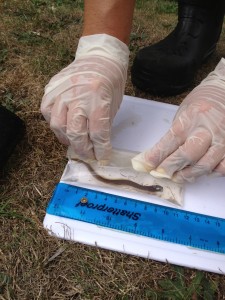
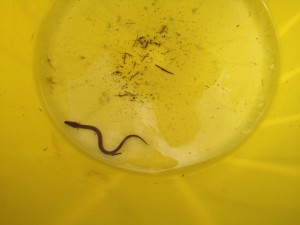
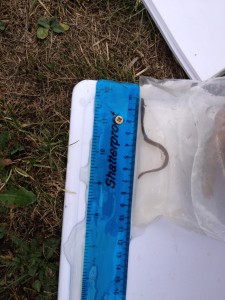
Update 2nd September 2013
Ciara and her eel whispering partner Lucy seem to have the magic touch! Their next trap check on 2nd September found another eel waiting in the trap. The Lone Ranger was an elver rather than a yellow eel, but further evidence that the eel tiles recently installed may be starting to show a positive effect on the eels’ migration routes.
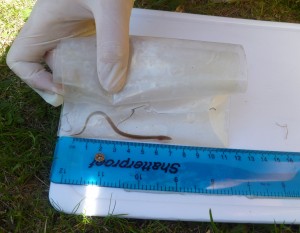
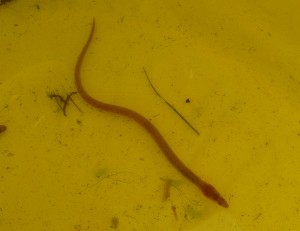
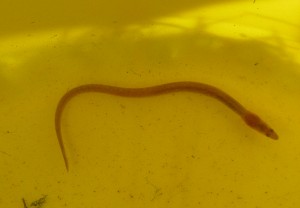
Update 5th September 2013
The trap checkers were delighted to report that another eel had been found in the trap; unfortunately this one will have to be known as ‘The One That Got Away’ as the excitement was such that they only realised they hadn’t photographed it as they watched it swim away upon release! Despite the eel being media shy, it’s still great news and further reinforces the hope that the eel tiles are starting to benefit the eels.
The trap checking ended in September and will commence again in April 2014. I’m sure I’m not the only one hoping that more eels will be found next year so keep an eye out for the next round of eel spotting!
Update March 2014
Eel training (for me, not the eels!) is only a couple of weeks away! Watch this space for this year’s instalment of eel monitoring in the Thames. Kingston University Biodiversity Action Group and the South East Rivers Trust have recently been working on habitat restoration near the monitoring site – watch this space for my own report on this as well as I’ve been helping out with this too.
Getting involved in citizen science
There are all sorts of citizen science projects being run and it’s not just a UK method of getting involved, there are projects across the world using volunteers to help with conservation and other projects. If you want to get involved in something like this it’s a good idea to check out the ZSL website, or contact your local equivalent. Get in touch with sea life centres, zoos, conservation groups etc. and see what’s going on in your area. It doesn’t need to be a huge commitment, my eel trap checking took about twenty minutes each time; you can just do whatever you can fit in.
We’ve put together an article which will be something of a work in progress as we add to it all the time, but it should help you get some ideas about things you can get involved with:
Getting involved with conservation and volunteering
Further reading and information
ZSL Conservation – get involved
BBC Nature – how to work with wildlife
Convention on International Trade in Endangered Species (CITES)
International Union for Conservation of Nature (IUCN)
IUCN red list
Centre for Environment, Fisheries and Aquaculture Science (CEFAS) eel information
Eel Regulations 2007
ZSL European Eel Conservation
ZSL European Eel information
ZSL Citizen Scientists help save the European Eel
ZSL studies Thames eel habitats in decline
ZSL Famous London eel is vanishing from the Thames
ZSL information on the Sustainable Eel Group
The Zoological Society of London’s Citizen Science, European Eel monitoring project report 2012
Sustainable Eel Group – Accelerating the recovery of the European Eel
Europeaneel.com
Thames Anglers Conservancy – the ZSL eel monitoring in the Thames
The clean up of the RIver Thames – from The Telegraph online
The Thames: back from the dead? – from I, Science – the science magazine of Imperial College
Thames: the tale that the river told – from The Independent online
Latest ICES advice on European Eel – stocks remain critical (November 2013)
Threatened eels disappear in the ocean on their way to the Sargasso Sea (14th February 2014)
BBC Earth News – Eel reveals its migration secrets
Animals losing migratory routes? Devasting consequences of scarcity of ‘knowledgeable elders’
Eli the Eel – a mysterious migration
Jack Perks Photography – European Eel Project – Looking at the fastest declining fish species in the UK
World Fish Migration Day 2014 features a ZSL Eel Celebration Day
Author: Suzanne Constance
Photographs of the three amigos courtesy of Dr Juliet Dukes, photos of the Hogsmill Two courtesy of Ciara Fleming, photos of the Lone Ranger courtesy of ‘lucybabey’.
A big thanks to Joe Pecorelli of ZSL for proof-reading the technical bits and making sure I got it right!




